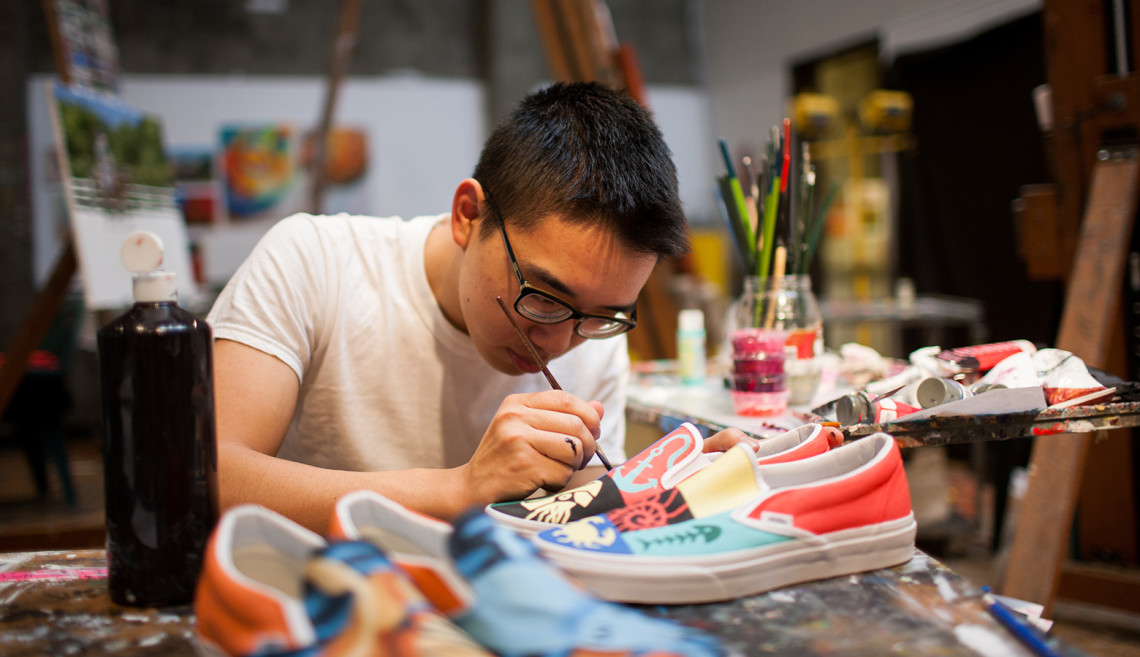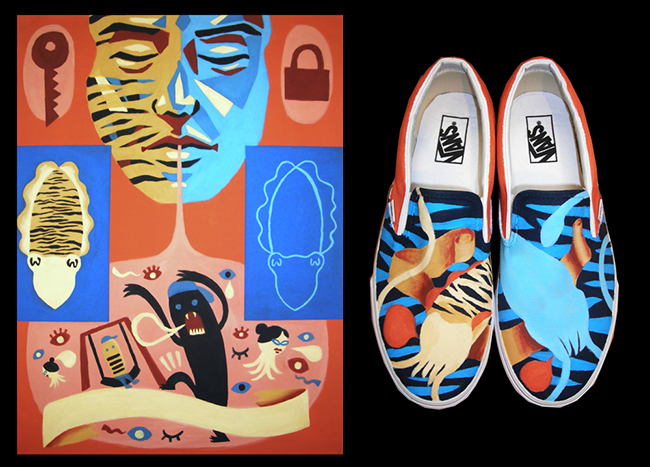 Yuto Watanabe
Yuto Watanabe
Captivated by Sea Creatures
Daniel Wong's new work Cephalo-Pod reflects his passions for art and biology.
When he was in first grade, Daniel Wong was obsessed with cephalopods, a class of marine animals that includes squids and octopuses. He would fill pages of his writing journal with an enormous list of all the animals he knew according to the oceanic zone they occupy. Wong, now a senior majoring in studio art and minoring in biology, received a Spark! Grant from the Stanford Arts Institute for his recent work, Cephalo-Pod. The collection consists of a series of four sets of hand-painted shoes paired with traditional flat paintings (acrylic on canvas). The work is currently on display in Wallenberg Hall as part of the YourArtHere program.

Daniel Wong
Cephalo-Pod is brazenly hued, buzzing with energy and punctuated by razor-edged shapes, variously polygonal and amoebic. In creating it, Wong sought to reoccupy his childhood psyche and examine the basis of his obsession with sea creatures. “I think the big characteristic about cephalopods that might have drawn me to them is just the absurdity of their form. I guess I was interested in how strange and mysterious and feared they are,” he explained. The work vividly embodies his preoccupation—it reveals both an essentially scientific interest in the uncanny abilities these animals use to survive and a humanistic interest in people’s attempts to relate to them. “It’s sort of a scientific approach, like the way I would have examined those ocean biology books—almost from a clinical, taxonomic perspective—but at the same time with the understanding that animals have their own psychology and we project our own ideas of how animals think” onto them.
There are doctors I know that are definitely art collectors or oil painters or sculptors on the side—they kind of do it on the side of the profession, and it helps them with the stresses of being a physician.
The piece has layers of psychological meaning—it explores not only past emotional states but also the artist’s ongoing inner journey. “I think what I’ve realized about art and this process is how emotionally draining and psychologically draining it can be, because what you’re doing is pouring yourself out onto canvas for people to see,” he said. In a play on the meaning of cephalopod (“head-foot” in Greek), each pair of shoes—meant to reside beneath each corresponding painting—represents the outward, public expression of the contents of the cerebral dreamscape suspended above it. “I don’t think I’ve ever done a project that was this much of an exposition of my own inner psychological goings-on,” Wong said.
Though he’s received much recognition as an artist, and his artwork seems to provide him an important creative and emotional outlet, Wong said he doesn’t envision a career as a professional artist: “I’ve concluded that I don’t think I’ll be able to survive in the art world just because I will always wonder if there’s more, I will always wonder if I’m doing enough: Is what I’m doing as an artist really affecting anyone?”
Having volunteered at the Pacific Free Clinic in San Jose for a number of years and shadowed several physicians at Stanford Hospital, Wong has decided to pursue a career that will satisfy his passion for biology: medicine. “I think it’s the closest to human truth as you could possibly get—being a doctor and understanding how the body works and learning how to heal it,” he said.

Yuto Watanabe
Regarding the pursuit of his dual passions, “there are doctors I know that are definitely art collectors or oil painters or sculptors on the side—they kind of do it on the side of the profession, and it helps them with the stresses of being a physician,” he said. “I definitely see that in my future, being a physician-artist.” Compared to a career as an artist, “being a physician is different because you are emotionally invested in what you’re doing but you’re not creating. It’s not a part of your ego and a part of your soul that you’re putting out there.”
Right now, Wong is at work on a colossal 5-by-6-foot painting for his spring quarter solo show May 21-30 in the Cummings Art Building Lobby. His new pieces explore what it means to occupy physical space—a topic he’s been pondering as he hunts for study areas on campus in which to polish off the work of his undergraduate career.
